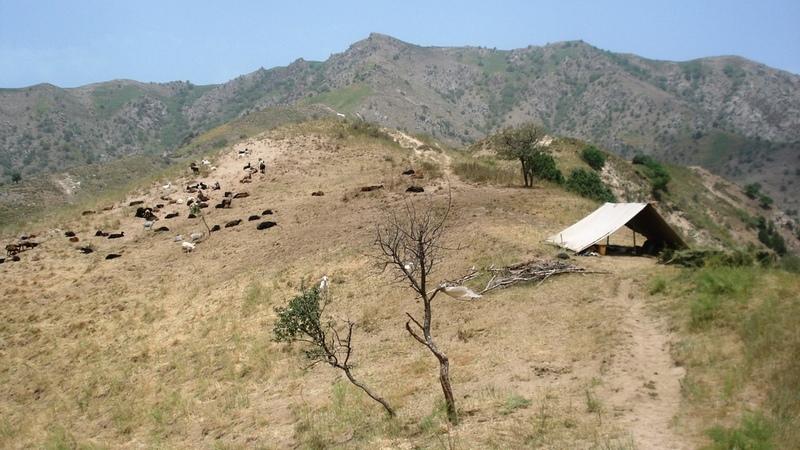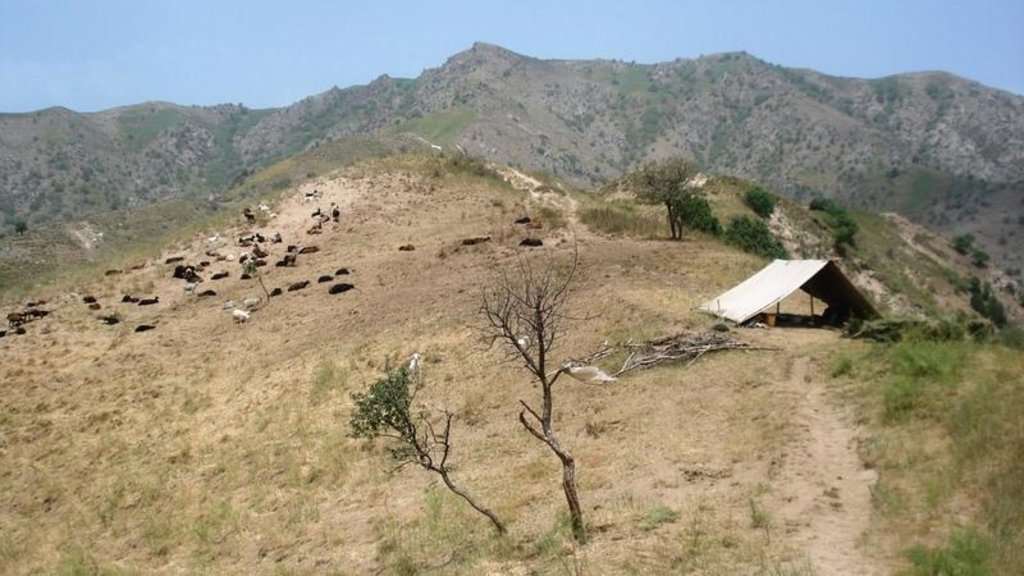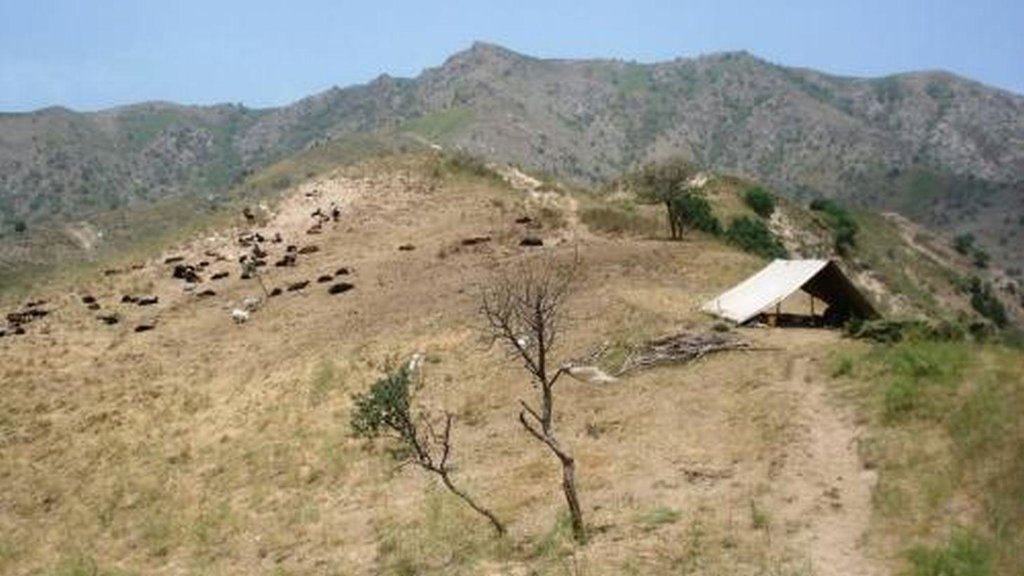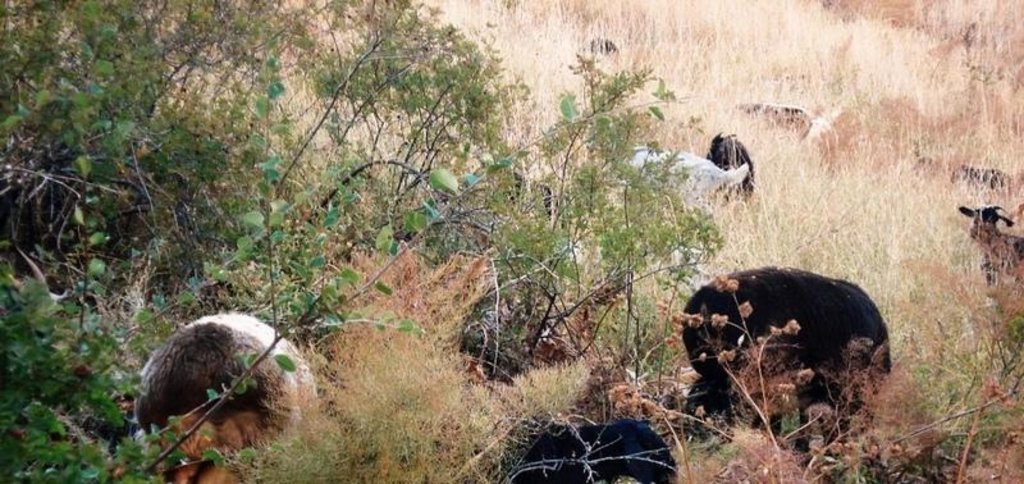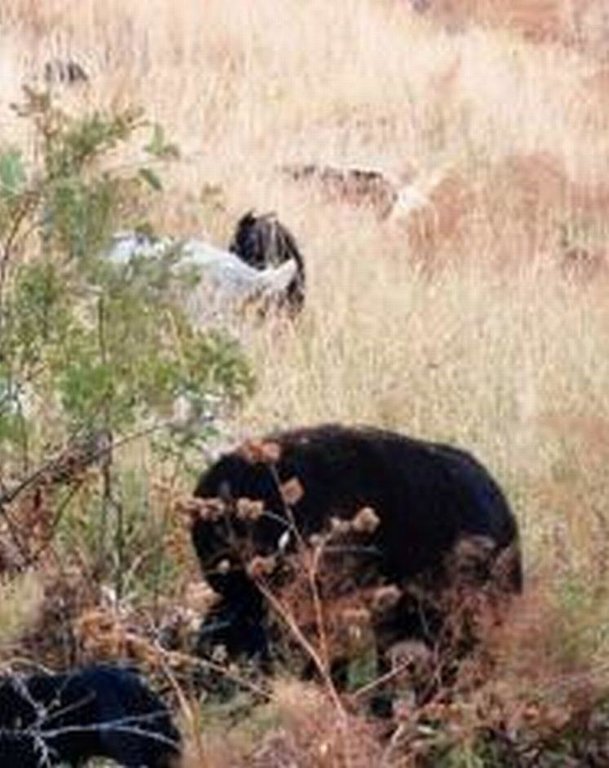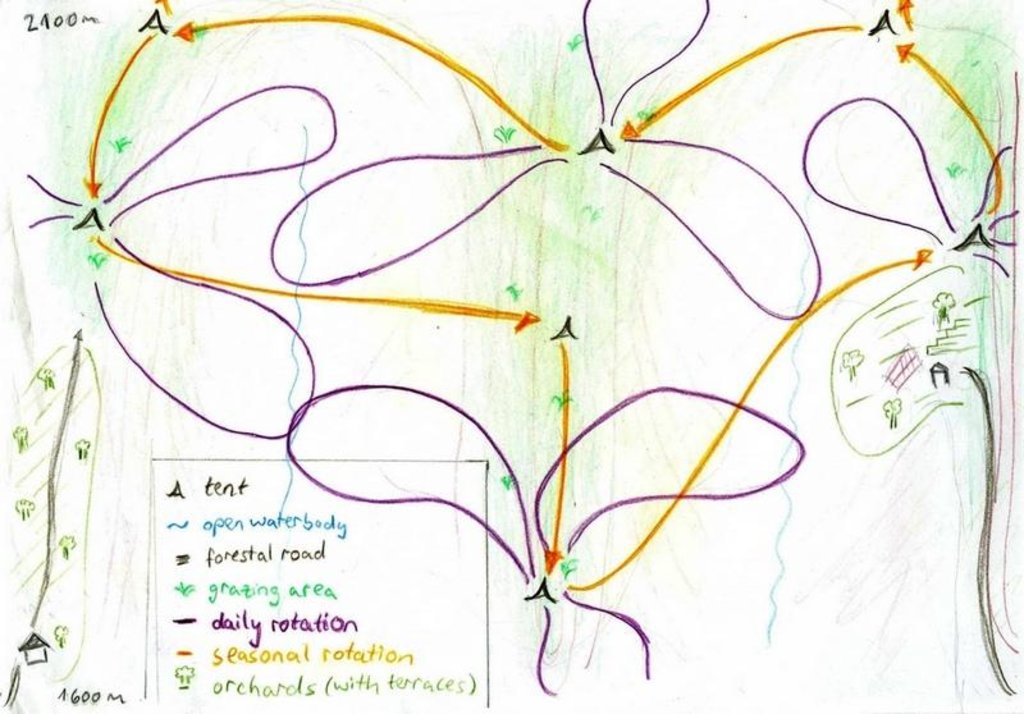Daily and seasonal rotation on grassland [Tajikistan]
- Creation:
- Update:
- Compiler: Christian Wirz
- Editor: –
- Reviewers: David Streiff, Alexandra Gavilano
Dajmardei Kaspi (professional herder)
technologies_1407 - Tajikistan
View sections
Expand all Collapse all1. General information
1.2 Contact details of resource persons and institutions involved in the assessment and documentation of the Technology
Name of the institution(s) which facilitated the documentation/ evaluation of the Technology (if relevant)
CDE Centre for Development and Environment (CDE Centre for Development and Environment) - SwitzerlandName of the institution(s) which facilitated the documentation/ evaluation of the Technology (if relevant)
NCCR North-South (NCCR North-South) - Kyrgyzstan1.3 Conditions regarding the use of data documented through WOCAT
The compiler and key resource person(s) accept the conditions regarding the use of data documented through WOCAT:
Yes
1.5 Reference to Questionnaire(s) on SLM Approaches (documented using WOCAT)
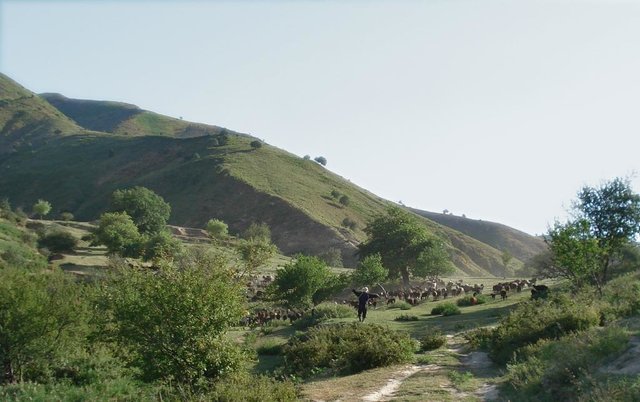
Seminomadic individual herding [Tajikistan]
Pasture management by a single herder, assisted either by an employee or by his own grandchildren, in collaboration with the habitants of the nearby village Karsang.
- Compiler: Christian Wirz
2. Description of the SLM Technology
2.1 Short description of the Technology
Definition of the Technology:
Extensive grazing of sheep and goats by the means of a precise rotational scheme
2.2 Detailed description of the Technology
Description:
Half-year herding with 500 sheep, goats and cows (very few), with 7-8 different locations of the herder's tent. The herder visits each place twice to thrice per grazing season and stays in one place for one week to maximally one month (during the Ramadan period, due to limited forces). The area is grazed from the higher zone (around 2000m) to the lower zone (around 1600m) twice per season, in a sort of circle. Every day the herder starts in another direction from his tent and leads the animals to the pastures, once in the morning and once in the evening. He passes a stream once (autumn) to twice (summer) a day.
Purpose of the Technology: The grass should not get dusty and dirty, explaining why the herder daily changes the pastures, only revisiting the same places every two to three days.
Establishment / maintenance activities and inputs: After accompanying his father as a child and a kind of an apprenticeship (of one year) later on, M. is considered by the villagers as a good herder and they give him their animals for herding. But M. applies for land on the forest department only after working as a guardian and as a tractor driver for 20 years. For the herding profession observing the animals precisely is necessary, in order not to lose any of them. And the maintenance of the pastures is guaranteed by the strict rotational scheme.
Natural / human environment: The pasture-area is in a generally well-conserved state. Moderate to high values of fractional vegetation cover can be observed and only few signs of recent erosion processes (through water) are visible. The area is characterised by steep slopes where still signs of past tree-planting during the USSR period are visible by some trees, many little platforms made for tree-planting and a few terraced areas. Eventhough, many trees have been grazed and do not stand anymore. Besides steep areas there are small, quite flat areas (where the herder installs his tents), that used to be cultivated (wheat) till 1966. These areas generally have low cover-values and signs of rill-erosion, which the herder attributes to the past tilling activity. However, it might also be the trampling and sitting of the animals (staying near the herder's tent at noon-time and during the night) causing this erosion. Nutrient management is provided for by the dung of the animals which is not collected, contrarily to the pastures near the villages.
2.3 Photos of the Technology
2.5 Country/ region/ locations where the Technology has been applied and which are covered by this assessment
Country:
Tajikistan
Region/ State/ Province:
Region of Republican Subordination
Further specification of location:
Faizabad
Comments:
Total area covered by the SLM Technology is 3 km2.
The half of the herded area is rented by another person from the village, who gives his animals to the herder. Apart from the interviewed herder there are varying numbers of other semi-nomadic herders with similar management practices, some of them from other regions.
Map
×2.6 Date of implementation
If precise year is not known, indicate approximate date:
- more than 50 years ago (traditional)
2.7 Introduction of the Technology
Specify how the Technology was introduced:
- as part of a traditional system (> 50 years)
Comments (type of project, etc.):
There are traditional herding peoples like Kuagwates, Kaleks, Lakais, Duramanes, Kurtshaliks), not Tajiks. These often move around with their whole families.
3. Classification of the SLM Technology
3.2 Current land use type(s) where the Technology is applied

Grazing land
Extensive grazing:
- Semi-nomadic pastoralism
Animal type:
- goats
- sheep
- cows
Species:
goats
Count:
500
Species:
sheep
Count:
500
Comments:
Livestock density (if relevant):
< 1 LU/km2
Major land use problems (compiler’s opinion): The trampling of the animals near the tent, the feeding on young trees and the daily passage of the herd of a limited number of streams (eutrophication).
Major land use problems (land users’ perception): No major land use problems due to good management. Only the first rain that cannot be absorbed by the dry soils is a problem.
Semi-nomadism / pastoralism: sheep* / goats* / cows
Future (final) land use (after implementation of SLM Technology): Grazing land: Ge: Extensive grazing land
3.4 Water supply
Water supply for the land on which the Technology is applied:
- rainfed
Comments:
Specify:
Longest growing period in days: 270Longest growing period from month to month: Oct - Jun
3.5 SLM group to which the Technology belongs
- pastoralism and grazing land management
3.6 SLM measures comprising the Technology

management measures
- M1: Change of land use type
- M4: Major change in timing of activities
Comments:
Main measures: management measures
3.7 Main types of land degradation addressed by the Technology

chemical soil deterioration
- Cn: fertility decline and reduced organic matter content (not caused by erosion)

biological degradation
- Bs: quality and species composition/ diversity decline
Comments:
Secondary types of degradation addressed: Cn: fertility decline and reduced organic matter content, Bs: quality and species composition /diversity decline
Main causes of degradation: overgrazing (Causing Pc, Bc, Wt), droughts (Causing Pk, Pc, Ha), degradation of near-village pastures (The pressure on more distant areas increases)
Secondary causes of degradation: soil management (passed tilling with impact on Wt), floods (Intensive rains causing Wt), land tenure (Little interest in tree-planting if land can only be rented annually)
3.8 Prevention, reduction, or restoration of land degradation
Specify the goal of the Technology with regard to land degradation:
- prevent land degradation
Comments:
Main goals: prevention of land degradation
4. Technical specifications, implementation activities, inputs, and costs
4.1 Technical drawing of the Technology
Technical specifications (related to technical drawing):
Daily and seasonal rotation.
Location: Above Karsang. Faizabad / Tajikistan
Date: 05.08.09
Technical knowledge required for field staff / advisors: low (Obeying to what the herder says)
Technical knowledge required for land users: moderate (It is necessary to know how to lead animals, more than in the case of the common pasture-area)
Main technical functions: control of dispersed runoff: retain / trap, increase of biomass (quantity)
Secondary technical functions: improvement of ground cover, control of fires, palatable fodder
Change of land use type: From afforestation and limited use as cropland to extensive grazing
Major change in timing of activities: Introduction of a strict rotational grazing scheme
Author:
Christian Wirz, Switzerland
4.2 General information regarding the calculation of inputs and costs
Specify currency used for cost calculations:
- USD
Indicate average wage cost of hired labour per day:
6.10
4.3 Establishment activities
| Activity | Timing (season) | |
|---|---|---|
| 1. | Buying a herd | constantly investing |
4.4 Costs and inputs needed for establishment
| Specify input | Unit | Quantity | Costs per Unit | Total costs per input | % of costs borne by land users | |
|---|---|---|---|---|---|---|
| Other | Buying a herd | animals | 50.0 | 87.7 | 4385.0 | 100.0 |
| Total costs for establishment of the Technology | 4385.0 | |||||
| Total costs for establishment of the Technology in USD | 4385.0 | |||||
Comments:
Duration of establishment phase: 12 month(s)
4.5 Maintenance/ recurrent activities
| Activity | Timing/ frequency | |
|---|---|---|
| 1. | Rent fee for land of forest department | once per year |
| 2. | Salary of an assistant herder (normally, but not in 2008) | at the end of the season |
| 3. | compensation for dead animals | at the end of the season |
| 4. | Animal medecine | if necessary |
| 5. | Salt | daily |
4.6 Costs and inputs needed for maintenance/ recurrent activities (per year)
| Specify input | Unit | Quantity | Costs per Unit | Total costs per input | % of costs borne by land users | |
|---|---|---|---|---|---|---|
| Labour | Salary of an assistant herder | Days | 120.0 | 6.1 | 732.0 | 100.0 |
| Other | Rent fee for land of forest department | 300ha/d | 180.0 | 0.4888888 | 88.0 | 100.0 |
| Other | Compensation for dead animals | animals | 2.0 | 44.0 | 88.0 | 100.0 |
| Other | Animal medecine | per year | 1.0 | 88.0 | 88.0 | 100.0 |
| Other | Salt | kg | 1000.0 | 0.08 | 80.0 | 100.0 |
| Total costs for maintenance of the Technology | 1076.0 | |||||
| Total costs for maintenance of the Technology in USD | 1076.0 | |||||
Comments:
The costs are valid for a herd of 250 animals kept by the herder alone for six months and additional 250 animals kept during summer holidays with the help of additional workforce. The salary indicated was not valid for 2008 (the grandsons helped the herder), but for years when M. hires external workforce. For all costs, including 50 own animal, prices in 2008 are taken.
4.7 Most important factors affecting the costs
Describe the most determinate factors affecting the costs:
Buying an own herd and looking for the animals are the most expensive factors, expecially if there are sick or dead animals.
5. Natural and human environment
5.1 Climate
Annual rainfall
- < 250 mm
- 251-500 mm
- 501-750 mm
- 751-1,000 mm
- 1,001-1,500 mm
- 1,501-2,000 mm
- 2,001-3,000 mm
- 3,001-4,000 mm
- > 4,000 mm
Specifications/ comments on rainfall:
Mainly in spring and also in autumn, with a trend to decrease
Agro-climatic zone
- semi-arid
Thermal climate class: temperate
5.2 Topography
Slopes on average:
- flat (0-2%)
- gentle (3-5%)
- moderate (6-10%)
- rolling (11-15%)
- hilly (16-30%)
- steep (31-60%)
- very steep (>60%)
Landforms:
- plateau/plains
- ridges
- mountain slopes
- hill slopes
- footslopes
- valley floors
Altitudinal zone:
- 0-100 m a.s.l.
- 101-500 m a.s.l.
- 501-1,000 m a.s.l.
- 1,001-1,500 m a.s.l.
- 1,501-2,000 m a.s.l.
- 2,001-2,500 m a.s.l.
- 2,501-3,000 m a.s.l.
- 3,001-4,000 m a.s.l.
- > 4,000 m a.s.l.
Comments and further specifications on topography:
Altitudinal zone: Pasture area around 1600 to 2000 m
Landforms ridges: Small, not so steep areas where the tent of the herder is installed
Landforms mountain slopes: The pasture area is generally very steep
Slopes on average steep (31-60%): The areas mostly frequented are steep
Slopes on average very steep (>60%): The areas dominating spatially are very steep
Slopes on average hilly (16-30%): Ridge areas
5.3 Soils
Soil depth on average:
- very shallow (0-20 cm)
- shallow (21-50 cm)
- moderately deep (51-80 cm)
- deep (81-120 cm)
- very deep (> 120 cm)
Soil texture (topsoil):
- medium (loamy, silty)
Topsoil organic matter:
- low (<1%)
If available, attach full soil description or specify the available information, e.g. soil type, soil PH/ acidity, Cation Exchange Capacity, nitrogen, salinity etc.
Soil depth on average shallow: Most grassy areas
Soil fertility is low: on the surface of 300 ha the summed up dung of 500 sheep and goats cannot compensate for the loss of topsoil by wind and water
Soil drainage / infiltration is good: Generally high infiltration capacity enhanced by high vegetation cover values
Soil water storage capacity medium (dominatig the area): Loamy soils and high cover values, but generally little trees and dried vegetation in August
Soil water storage capacity can also be good: Near the streams higher water retention, according to herder
5.4 Water availability and quality
Availability of surface water:
poor/ none
Water quality (untreated):
for agricultural use only (irrigation)
Comments and further specifications on water quality and quantity:
Water quality (untreated): Locals drink the water, but are affected by diarrhoea
5.5 Biodiversity
Species diversity:
- high
Comments and further specifications on biodiversity:
Diversity higher than near the villages, but not comparable with biodiversity hot-spots
5.6 Characteristics of land users applying the Technology
Sedentary or nomadic:
- Semi-nomadic
Off-farm income:
- less than 10% of all income
Relative level of wealth:
- rich
Individuals or groups:
- individual/ household
Gender:
- men
Indicate other relevant characteristics of the land users:
Land users applying the Technology are mainly common / average land users
Difference in the involvement of women and men: Herding is considered as a male profession, inherited from father to son. In nomadic peoples the whole families are mobile and women are responsible for domestic work.
Population density: < 10 persons/km2
Annual population growth: 1% - 2%
100% of the land users are rich (100).
Off-farm income specification: The herder claims to nourish himself and his wife with the income from herding. But, once he willl not be able to work as a herder anymore, he might depend on off-farm income from his children (remittances)
5.7 Average area of land used by land users applying the Technology
- < 0.5 ha
- 0.5-1 ha
- 1-2 ha
- 2-5 ha
- 5-15 ha
- 15-50 ha
- 50-100 ha
- 100-500 ha
- 500-1,000 ha
- 1,000-10,000 ha
- > 10,000 ha
Is this considered small-, medium- or large-scale (referring to local context)?
- small-scale
Comments:
3 households can afford to pay the services of the professional herder (clearly a minority of village population)
5.8 Land ownership, land use rights, and water use rights
Land ownership:
- state
Land use rights:
- leased
Water use rights:
- communal (organized)
5.9 Access to services and infrastructure
health:
- poor
- moderate
- good
education:
- poor
- moderate
- good
technical assistance:
- poor
- moderate
- good
employment (e.g. off-farm):
- poor
- moderate
- good
markets:
- poor
- moderate
- good
energy:
- poor
- moderate
- good
roads and transport:
- poor
- moderate
- good
drinking water and sanitation:
- poor
- moderate
- good
financial services:
- poor
- moderate
- good
6. Impacts and concluding statements
6.1 On-site impacts the Technology has shown
Socio-economic impacts
Production
fodder production
Comments/ specify:
Higher vegetation cover and biomass values than for village-pastures
fodder quality
Comments/ specify:
Much less impalatable species' frequency
animal production
Comments/ specify:
The animals get much fatter and are sold for around 50% higher price than animals from common pastures
wood production
Comments/ specify:
The herder says that tree density has decreased, due to livestock but also to chopping. Additionally chopping of living trees is generally forbidden (since the 1960s, when the forest department was created as a new land use type), not making possible the
production area
Comments/ specify:
The use of the land for fruit production is not possible with animals grazing, but this was also the case before, as to the herder's opinion
Water availability and quality
irrigation water quality
Comments/ specify:
Due to reduced stocking rates in comparison with village-pastures (and the soviet times), better water quality
Socio-cultural impacts
food security/ self-sufficiency
health situation
recreational opportunities
Livelihoods and human well-being
Ecological impacts
Water cycle/ runoff
surface runoff
Comments/ specify:
Better control of runoff, but steeper land
excess water drainage
Soil
soil cover
Quantity before SLM:
40%
Quantity after SLM:
80%
Comments/ specify:
Higher cover than on village-pastures
Biodiversity: vegetation, animals
plant diversity
Quantity before SLM:
36 species
Quantity after SLM:
47 species
Comments/ specify:
More plant systematical diversity
Climate and disaster risk reduction
fire risk
Comments/ specify:
According to forest department the area above Karsang, due to ist trees, is more prone to fires than other areas
6.3 Exposure and sensitivity of the Technology to gradual climate change and climate-related extremes/ disasters (as perceived by land users)
Climate-related extremes (disasters)
Climatological disasters
| How does the Technology cope with it? | |
|---|---|
| drought | not well |
Other climate-related consequences
Other climate-related consequences
| How does the Technology cope with it? | |
|---|---|
| reduced growing period | well |
Comments:
A possible adaption to dryer conditions would be smaller herds.
6.4 Cost-benefit analysis
How do the benefits compare with the establishment costs (from land users’ perspective)?
Short-term returns:
neutral/ balanced
Long-term returns:
very positive
How do the benefits compare with the maintenance/ recurrent costs (from land users' perspective)?
Short-term returns:
slightly positive
Long-term returns:
positive
Comments:
4 Years ago a herd of 400 animals had to be sold due to disease. Since then M was able to rebuild a herd of 500 animals. On a short term investing into animals is expensive but pays quickly. The maintenance costs are finally decisive, but quite constant.
6.5 Adoption of the Technology
- single cases/ experimental
If available, quantify (no. of households and/ or area covered):
1 Household
Of all those who have adopted the Technology, how many did so spontaneously, i.e. without receiving any material incentives/ payments?
- 0-10%
Comments:
100% of land user families have adopted the Technology with external material support
1 land user families have adopted the Technology with external material support
Comments on acceptance with external material support: The herder gets paid by the villagers for taking care of their animals
There is no trend towards spontaneous adoption of the Technology
Comments on adoption trend: According to the herder, young people do not (want to) bear the very physical work.
6.7 Strengths/ advantages/ opportunities of the Technology
| Strengths/ advantages/ opportunities in the land user’s view |
|---|
|
Grazing stabilises the soils and is thus a prevention against gully erosion in areas with low cover (former cropland). Animals have the same effect as the terraces built years ago. How can they be sustained / enhanced? Grazing activity should continue, once M. is too old for working. |
| The animals provide for soil fertility by their dung, instead of the fertilisers used in Soviet times. This positively influences the share of palatable plants and cover in general and, by this, soil moisture. |
| The area on the forest department is a good alternative to the much too small pasture-area near the village |
| Strengths/ advantages/ opportunities in the compiler’s or other key resource person’s view |
|---|
|
Form of land use making it possible to take some pressure from the common pastures without great damages. How can they be sustained / enhanced? It needs to be assured that also poorer families, who depend even more on livestock breeding than richer ones, can give their animals to M. or other professional herders. This could be realised by engaging herder assistants from poor families |
|
The rotational scheme is much more elaborated than in the case of the villages' pastures, which can be explained by more land available How can they be sustained / enhanced? Land users like M. should be addressed by forest administration to elaborate legal forms of herding with little damages on natural resources on this land. This will probably require land reforms. |
6.8 Weaknesses/ disadvantages/ risks of the Technology and ways of overcoming them
| Weaknesses/ disadvantages/ risks in the land user’s view | How can they be overcome? |
|---|---|
| Tree planting is not possible as long as the area is used for grazing. | By giving people land for longer periods (than one year) and with more freedoms in its use, people would gain interest in diversifying use: They would split up "their" land into haymaking, orchard and pasture areas. |
| Weaknesses/ disadvantages/ risks in the compiler’s or other key resource person’s view | How can they be overcome? |
|---|---|
| The main problem of this form of grazing is that it doesn't allow the regrowth of trees. | Changing the areas use for grazing, respectively haymaking, every few years. |
| Cover is markedly reduced around the places where tents are installed. | By changing the camping place (but: limited flat areas!) or not keeping the animals in the same place at noon time and during night time, these areas might recover. |
7. References and links
7.1 Methods/ sources of information
Links and modules
Expand all Collapse allLinks

Seminomadic individual herding [Tajikistan]
Pasture management by a single herder, assisted either by an employee or by his own grandchildren, in collaboration with the habitants of the nearby village Karsang.
- Compiler: Christian Wirz
Modules
No modules


